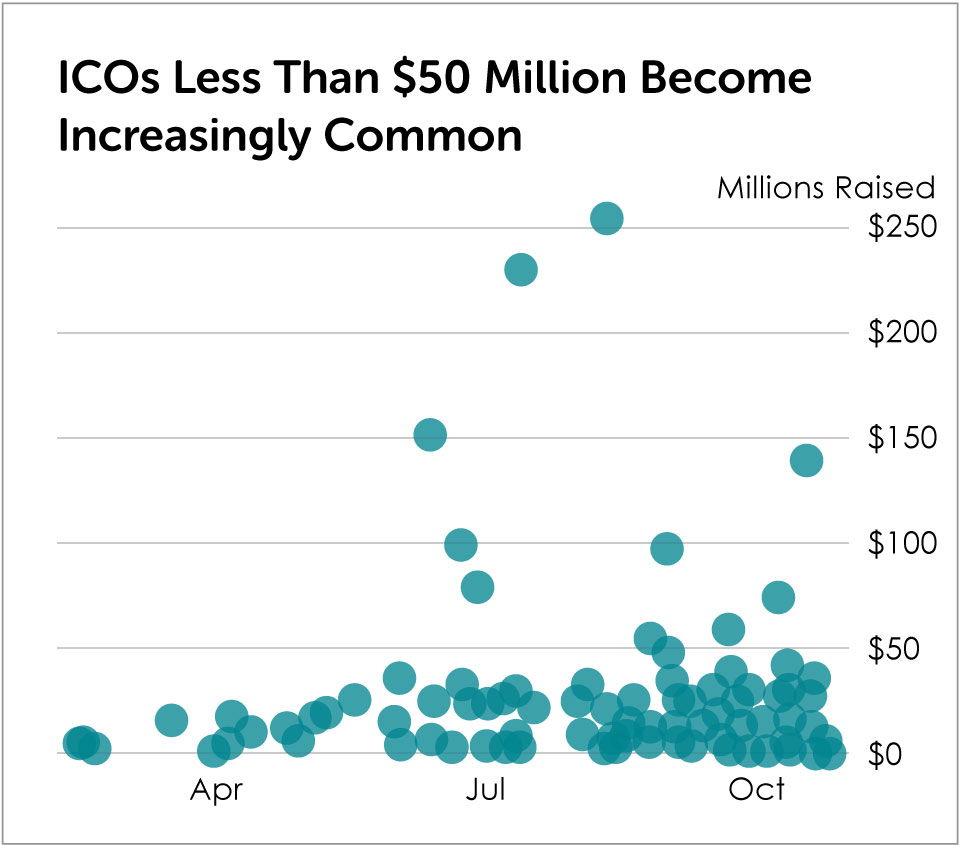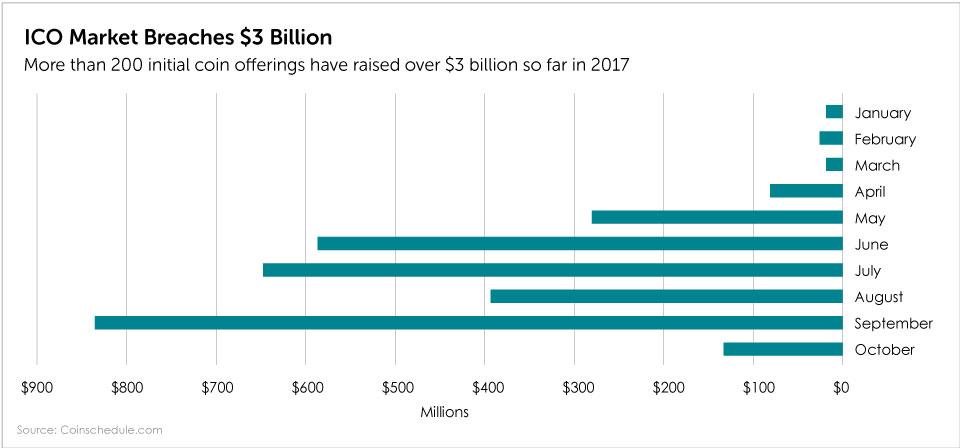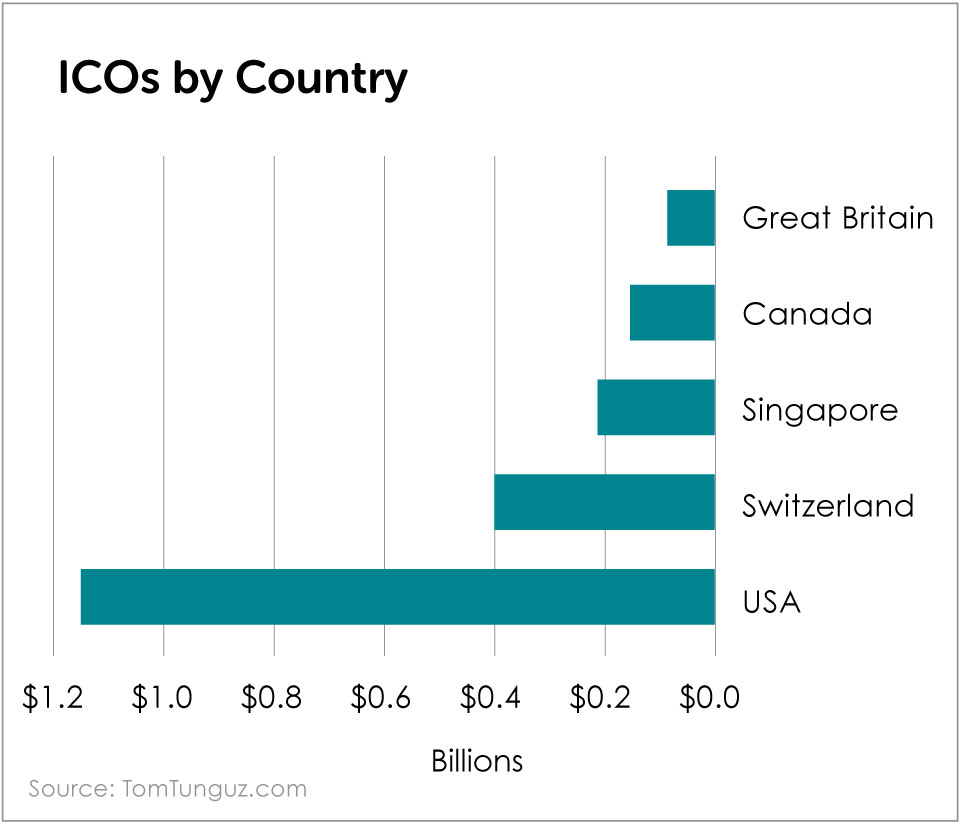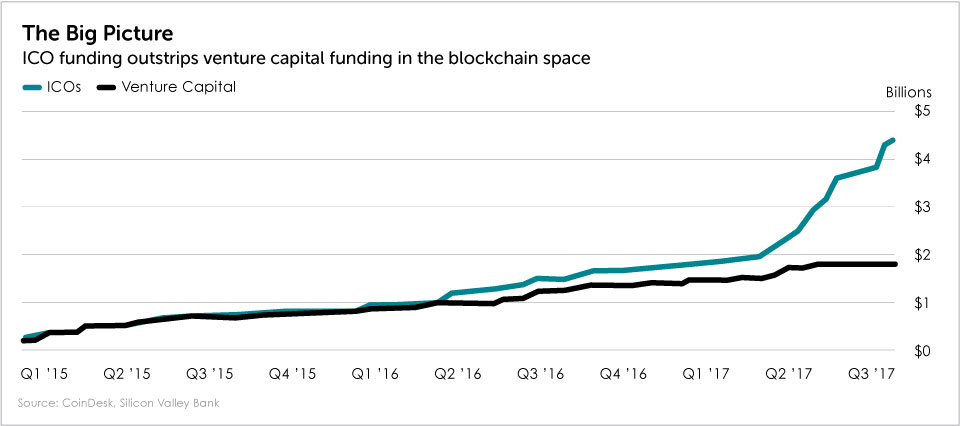Cryptocurrencies and Governments Collide
Early adopters in the cryptocurrency space have known for a while now that regulation is inevitably coming to the cryptocurrency (aka crypto) world.
To be clear, this is not a bad thing.
If done well, regulation could bring stability and legitimacy.
It could help nudge crypto further into the mainstream, fostering the development of exchange-traded funds and other investment vehicles that will allow more retail and institutional investors to buy in.
Many countries, including China and Russia, are now working on legal frameworks for cryptocurrencies.
However, the U.S. Securities and Exchange Commission still seems to be taking a hands-off approach and has yet to issue clear guidelines on crypto.
The big news this month, however, is that some governments are beginning to signal a shift toward cryptographic, blockchain-based fiat currencies.
Government-Issued Cryptocurrencies
In late October, there was some stunning news out of Russia involving cryptocurrencies.
President Putin green-lighted the launch of a cryptographic version of Russian currency, dubbed the “CryptoRuble.”
The CryptoRuble will be exchangeable with existing Russian rubles (digital and physical) on a 1-to-1 basis. Unlike bitcoin, the CryptoRuble will not be mined.
It will be a centrally controlled currency issued by the government… but it will be based on blockchain technology.
Russian Minister of Communications Nikolai Nikiforov explained the “why” of the sudden announcement: “I confidently declare that we run CryptoRuble for one simple reason: If we do not, then after two months our neighbors in the EurAsEC [Eurasian Economic Community] will.”
In other words, Russia sees the development of national cryptocurrencies as inevitable and is looking to get a jump on the competition.
And indeed, competition in this area is coming. Dubai beat Moscow to the punch when it announced the creation of its own state-issued cryptocurrency called “emCash.” EmCash will be legal tender throughout the United Arab Emirates.
Days later, Kazakhstan announced it was developing its own state-controlled cryptocurrency. As reported by CNBC, Kairat Kelimbetov, governor of the government-backed Astana International Finance Center (AIFC), said in a press release…
Blockchain and cryptocurrencies are entering the mainstream of today’s economic reality.
We believe that the AIFC can become an international hub for blockchain operations, and the development of the digital assets market is our key priority in the near future.
Dawn of the Crypto Age
I believe these recent developments signal the beginning of the crypto age.
They are an acknowledgment that blockchain-based money is the future.
Even crypto critics admit that crypto’s blockchain technology is one of the most important financial innovations in history.
JPMorgan’s Jamie Dimon, for example, called bitcoin a “fraud,” yet his bank is enthusiastically working on ways to incorporate blockchain tech.
Existing monetary systems use outdated technology. Switching to a blockchain version will certainly be an upgrade.
But while governments will create their own cryptocurrencies, these versions will suffer from the same problems existing fiat currencies do.
They will still be centralized, meaning control will reside in the hands of bankers, academics and politicians.
And central banks will still be able to print endless amounts of cryptocurrency (though it will be far more efficient on a blockchain).
Furthermore, creating a new version of an old currency will not rid the system of unsustainable debt.
The development of government-backed cryptocurrencies does not affect our investment thesis. These new government “coins” will not be competitors to our portfolio holdings in any way.
The primary appeal of cryptocurrencies like bitcoin is that they are decentralized and not controlled by anyone, so the number of coins can be strictly limited.
Government-backed crypto is simply the old monetary order borrowing technology from the new. ■
RETIREES: If You Own Gold, Read THIS
Gold is a great security measure for your portfolio. BUT if you’re retired and need regular income, it’s not much help.
That’s why Andy Snyder, founder of Manward Press, has developed a unique way to collect SUPERCHARGED retirement income – as much as $5,167 every month.
To see how, click here, or call844.201.1980 or 443.541.4636 and mention priority code GMTDTA00.
founder q&a
A Little Closer to the Endgame
An Interview With Napa Valley Distillery Co-Founder and CEO Arthur Hartunian
In late July of this year, we recommended Napa Valley Distillery (NVD). This recommendation was a different kind of startup opportunity, as it was a chance for investors to earn cash immediately.
This opportunity was called “revenue sharing” or “revenue participation.” Basically, they’re loans (technically “promissory notes”) made to companies like NVD.
While NVD’s current raise is closed, we continue to look for other promising revenue sharing opportunities to add to our portfolio.
I recently caught up with NVD’s co-founder and CEO, Arthur Hartunian, to see how things have been going for the company since its initial raise.

Andy: Thanks for agreeing to update us on NVD’s latest news. For new members who may not be familiar with your company, give us a quick tour.
Arthur: Thank you, Andy. A lot has happened since your members invested in our revenue sharing raise in late July.
They invested in an ongoing, revenue-producing micro-craft distillery.
Everybody else around Napa Valley makes wine. We make spirits, typically in small batches. I guess we’re best known for our award-winning Meyer Lemon Liqueur and Napa Vodka, made with single vintage Napa Valley Sauvignon Blanc wine grapes.
Our production facility also houses a tasting salon and event center. And we have a second shop and tasting room in downtown Napa Valley.
I should also mention our Distinguished Bar Club. Members get a package of bottles and other stuff every quarter.
Andy: Could you also tell us why you were raising money earlier this summer?
Arthur: Basically to build a fully operating kitchen and restaurant, so we can serve cocktails, beer and wine throughout the day and evening. It’s taking advantage of a new law passed in California.
Andy: How’s the expansion coming along?
Arthur: Great. The kitchen will begin construction next year. Even without a kitchen, we’re growing 10% to 15% a year.
Andy: Any other exciting new developments?
Arthur: Yes, we just launched a new bourbon called “Son of a Bourbon,” or S.O.B. for short. Our launch party was a huge success.
Andy: What’s new or special that you’re focusing on these days?
Arthur: My top priority now is expanding our distribution and exports.
We’re talking to a global distributor who specializes in growing sales domestically and overseas, and he’s encouraging us to set very ambitious goals.
We’re also expanding staff, making it more sales-oriented than before. So our payroll spend has increased, but our revenue growth will more than make up for it, I figure, starting about 90 days or so from now.
Andy: Operation-wise, what are you doing to prepare for this big step?
Arthur: We’ve been building up inventory during the last six months, which in our business means pre-barrel, when product is being stored and aged. We’re up to almost $8 million in inventory, much more than there was this time last year.
The other thing to keep in mind is that we’re nowhere near full producing capacity. We can produce 10 times what we do now without adding equipment.
We should do around $2 million in revenue by the end of the year, better than the $1.7 million we did last year. And, remember, we’re achieving this with no new channels.
Andy: That’s the kind of news investors like to hear!
Arthur: Well, we don’t lack for good news, Andy. For example, we’re getting increasing recognition. USA Today recently named us one of the 10 best craft distilleries in the country. We’re the only one on the list from California, I might add.
Also, Afar magazine is doing a big spread on us that will be appearing in its holiday issue.
Andy: Any industry news that will impact NVD?
Arthur: We’re just continuing to track buyouts and valuations.
Another distillery two hours away was recently bought out by Gallo. It was doing about $3 million in revenue per year.
Ballast Point was pulling in around $65 million of revenue a year when it was bought for $1 billion earlier this year. Revenue to price, that’s about 15 times revenue. High West was doing around $12 million in revenue – by the way, I know the owner – when it was bought out for $160 million. That’s 13 times revenue.
The average buying price for a distillery these days is 13.5 times revenue. Ballast Point was north of that because it was on track to make $100 million the following year.
Andy: Interesting. I can almost see the wheels whirring in your head. So, given these numbers, what’s your exit plan?
Arthur: Our exit plan is something I think about every day, and every day I see NVD get a little closer to the endgame. First off, we’re already a target, perhaps a soft target for some of these larger companies at this point, but a target nonetheless. I’m sure of it. The industry is undergoing consolidation. We’re going to be part of it.
We’re also going to make sure the numbers work out for early investors. I see us exiting at some point in the next two to five years, perhaps more toward the end of that range. These things are hard to predict, as you well know.
In five years, we hope to be doing around $7 million in revenue. I’m being conservative – I hope it’s a lot more.
But, using the 13.5 times revenue multiple, our valuation should be in the vicinity of $94 million.
I’m aiming for a valuation of at least $100 million. It’s a nice round number, and it’s very doable.
Andy: That sounds exciting, Arthur. It’s a pretty compelling strategy.
Arthur: We think it’s something that will motivate our next wave of investors.
Andy: That’s right, you’re about to begin a fresh raise.
Arthur: Yes, it’ll be up and running on the MicroVentures portal. We hope to raise $1 million to $2 million. The minimum will be either $5,000 or $10,000.
Andy: And it’s available to only accredited investors, right?
Arthur: That’s right, under 506(c) rules.
With the money we’ll be raising in hand, we don’t have to turn away any opportunities to grow sales. We want to be as opportunistic as possible.
Andy: Thanks for the update, Arthur. And good luck with your upcoming raise.
I think investors will be getting a good deal. ■
The Oxford Club’s 20th Annual Investment U Conference
 Early Investing Co-Founder Adam Sharp has been invited to speak about investing in cryptocurrencies at The Oxford Club’s 20th Annual Investment U Conference next March 5-18 at the Four Seasons, Las Vegas.
Early Investing Co-Founder Adam Sharp has been invited to speak about investing in cryptocurrencies at The Oxford Club’s 20th Annual Investment U Conference next March 5-18 at the Four Seasons, Las Vegas.
The Club is thrilled to find out what Adam will reveal during his presentation. In the meantime, here’s a sneak peek of the cryptocurrencies insights he’ll reveal at this year’s conference.
Q: How long have you been involved in cryptocurrency?
Adam: I first started looking into bitcoin in 2012 when the price was around $5. I watched it quickly rise to $84 and decided to initiate a small position around that price in 2013. Long story short, it’s paid quite handsomely to get in at its infancy.
Q: It seems almost like investing in cryptocurrencies is effortless. Would you say it’s the easiest investment you’ve ever made?
Adam: Well, it’s certainly a lot easier than opening a brokerage account. Trading goes on 24 hours a day, all around the globe. And the process is constantly getting simpler and safer as the industry evolves.
Q: What makes 2018 such an important year to invest in cryptocurrencies, and how will you introduce attendees to these opportunities?
Adam: The key is to understand that we’re at the start of cryptocurrencies going mainstream, with bitcoin leading the way. It’s likely we’ll see institutional buying begin in earnest in 2018, so my readers are positioned to benefit from that. With cryptocurrency, it’s simple. Knowledge is key. I’ll provide the right information investors need to get started and to prosper.
Q: Any advice for those who haven’t gotten started yet?
Adam: Don’t wait for a huge pullback to get in. Start building a position now and add to it on dips. Doing so is a bet on a future where cryptocurrencies are a mainstream part of the monetary system. Far less than 1% of people own any cryptocurrency at all. It’s still early, even though the price has risen significantly.
To get a front-row seat to Adam’s presentation next March, here’s everything you need to know…
What’s happening: The Oxford Club’s goal at the 20th Annual Investment U Conference is to bring you the chance to connect with like-minded individuals, get inspired by brilliant speakers and discover the best investment ideas available today.
When it all takes place: The conference runs March 15-18, 2018.
Where to meet the Club: The venue is the Four Seasons in Las Vegas.
Who will be there: You’ll hear from the entire team of Oxford Club experts, as well as exciting guest speakers such as Senior Advisor to MIT’s Digital Currency Initiative Michael Casey and CEO of Sprott U.S. Holdings Rick Rule.
Why you need to attend: At the conference, you’ll learn how to master the art of intelligent speculation. This will include everything you need to know about today’s most successful strategies in cryptocurrency, microcaps, options trading and so much more.
Joining the Club at this gathering gives you the opportunity to explore innovative and profitable ideas that could change your life.


To get more information and to reserve your spot today, simply click here.
Playbook
Equity Crowdfunding Playbook Part 11
The 10 Clues to Identifying Killer Growth Before It Happens
Editor’s Note: This is Part 11 of a 12-part series called the First Stage InvestorEquity Crowdfunding Playbook. If you missed the previous installments, you can find them here: www.earlyinvesting.com/playbook/
At the end of the day, only one question matters…
Will the startup you invested in grow into a profitable, self-sustaining company?
Answering that question when a company is taking its first tentative steps is the fundamental challenge facing every early investor.
The better they can answer this question, the more success they will achieve.
But how do you predict future growth this early on?
And not just growth, but strong, rapid growth – even hypergrowth?
The good news…
Even at the seed stage (or thereabouts), there are clues. You simply need to know where to look.
So here are the 10 pre-growth signs of killer early traction I look for in seed-stage companies…
- A market that comes to you. Customers love the product. The market is pulling sales, rather than the company pushing sales. It’s as if the startup is offering food to a starving market. Products are flying off the shelves. Sales are booming. Growth seems to be taking place on its own.An example from our own portfolio is a company you may be familiar with (and perhaps invested in): Keen Home, a “smart home” company. Its supply contracts with retailers had to be constantly revised upward. We took this as a great early sign that killer traction might not be far off.
- Bootstrapping growth. “Bootstrapping” means growing a startup on a bare-bones budget. It’s not for everybody. The founders take on multiple roles, handling sales, ops, fundraising, product development, etc. They work harder and get paid less. They learn how to run a lean, capital-efficient business.We like to see this because it requires an extra dose of sacrifice and commitment. These founders are “all in.” Later on, they usually exhibit extraordinary amounts of determination and resiliency, which they’ll need to lead their startups through the tough times ahead. Our most recent recommendation, Arbit, is a good example of a bootstrapping company.
- Enthusiastic customer feedback. Fact is, a startup is only going to give you (the inquiring investor) feedback from customers it knows are happy with its product. Your counter-move: Look for not just positive feedback, but over-the-top enthusiasm… as in, “OMG, this is better than I could ever have imagined.”I call them “OMG customers.” If a startup has found 100 of them, it’s primed for serious revenue growth. A reasonable proxy for consumer product companies? Returns. I recently talked to a startup that has a return rate of less than 1%. It’s not exactly the same as OMG enthusiasm, but it’s pretty close and certainly got my attention.
- Powerful partners. They can offer entrées into lucrative markets faster and cheaper than a startup could find on its own. Our portfolio holding Virtuix is a good example. It signed up two huge and powerful Chinese companies, giving itself virtually instant access to a large swath of the Chinese market.It’s worth keeping an eye on how these partnerships play out. Some don’t work out for various reasons. But their impact on future revenues can be significant.
- Sticky products, sticky customers. I prefer products that help customers make more money over those that help them save money. Customers who make more money are stickier. If a company is saving a customer time and/or money, I look for BIG savings to increase stickiness and decrease churn (when customers stop using a company’s product).
- Little spend, big results. Is traction taking off from word of mouth and with no budget to speak of? If so, you can reasonably expect a steeper curve when the company ramps up its sales and marketing budget and begins selling in earnest.
- Been there, done that. You don’t see many of these companies… yet. We’ll be seeing more coming out of China, India and Europe and targeting the U.S. These aren’t your typical seed-stage companies. They have years of hard-won experience. Their products are already proven and popular. Their brands are already well-known. And they’ve already experienced rapid growth in several large markets.The perfect example of a “been there, done that” company? Our portfolio holding BrewDog. Before it set out to win over the U.S. market, it had already conquered Europe.
- Incipient growth. You’re not getting the luxury of 10 years of growth that Warren Buffett looks for. But if you can replace 10 years with 10 quarters, 10 months or even 10 weeks, that qualifies as a revenue track record worth examining.This belongs in the “something is better than nothing” category. For the founders, it’s also an invaluable period when they can learn more about their product based on feedback from these early customers. As an investor, you’re looking for a good product that has been (or is being) tweaked to better connect with customers.
- Pipeline deals. Founders often tell me what deals they’re working on. In the public stock world, that’s illegal. You’re not allowed to invest on such “privileged” information. Not so in the world of startup investing. It’s simply part of the discovery process.A word to the wise: If I had a dollar for every deal I thought I had sewn up but never consummated (in my former life as CEO of a global trade and finance company), I’d be a billionaire by now. Pipeline deals are pre-finalized and pre-contract. They can go south at the last minute. Never invest solely on a pipeline deal that can make or break a company’s future growth plans.
- Long sales cycles. This is usually not considered a positive. Long sales cycles require more time, effort and resources. While sales of consumer products can expand pretty quickly in best-case scenarios, it’s not so for enterprise-facing companies facing a longer sales cycle. But – and this is a BIG BUT – once these enterprise customers have integrated a new product into their internal operations, they’re not going to change suppliers on a whim.It’s very sticky. A great illustration of this is our portfolio company Court Innovations. Its customers are government agencies. It takes a while for them to sign on, but once they do, they’re not going anywhere. These government customers are the stickiest of all.
The more of these early clues you can assign to a startup, the better. There’s no magic number here. Any startup that hits two or more usually gets my attention.
I deliberately did not weigh any of the above 10 clues, but if I had to name a favorite, it would be the first one listed: a market that comes to you.
Predicting revenue growth ain’t easy. The thing is (and we’ve said this many times), you don’t have to be right all the time. You don’t even have to be right a majority of the time.
You just have to be right some of the time to reap huge gains from your startup portfolio. ■
charts of the month
Charts of the Month
ICO Market Now Greater Than $3 Billion in 2017… But Be Mindful
Initial coin offerings (ICOs) show no sign of slowing down.
The amount raised from ICOs this year through mid-September exceeded $2 billion, according to Bloomberg.
That amount has since surged to more than $3 billion from 200-plus ICOs in 2017, according to data from Coinschedule.com.
September, with $850 million raised from 37 offerings, was a particularly busy month for ICOs.
Here’s some additional data showcasing ICOs’ ability to raise huge amounts of money. The chart to the right shows the numbers and sizes of ICOs since the beginning of this year.

Filecoin raised $250 million. Its technology promises to enable the use of excess storage capacity on all kinds of computers – sort of an Airbnb for hard drives.
Tezos raised $232 million. It plans to create tokens (known as “Tezzies”) for use on a new type of software that governs contracts on a blockchain.
Bancor raised $153 million. Its protocol enables anyone to create a new type of digital coin called a Smart Token, which can hold and trade other tokens.

Eighteen ICOs have raised more than $100 million, while 120 have raised up to $50 million.
That’s a lot of money.
This recent surge in ICOs is even affecting traditional early-stage funding mechanisms, specifically venture capital.
According to data from CoinDesk and Silicon Valley Bank, the first quarter of 2017 looked a lot like previous quarters. Venture capital dwarfed ICO money. In Q1, $108 million in venture capital poured into the blockchain space, versus $38 million in ICO money.
Then the ICO floodgates burst open. In Q2, it was $235 million in venture capital and $785 million in ICO money.
It was quite a turnaround and looked like it might be an outlier… Until the third quarter rolled around, that is, with confirmation that ICOs had become the vastly preferred method of fundraising. The Q3 numbers were stunning: $6 million in venture capital and $1.26 billion in ICO money.
The only thing that could dampen ICO enthusiasm? The Securities and Exchange Commission warning that non-utility tokens could be treated as securities in future ICO raises. Adam suspects, though, that if there is an ICO pullback, it won’t be significant.

It’s also important to know where ICOs are coming from. Among the five countries with the highest number of ICO raises, the U.S. accounts for 57% of dollars raised. Switzerland, Singapore, Canada and Great Britain are the other major ICO-raising countries. But even cumulatively, they don’t amount to the U.S. total.
What this data shows is that ICOs and cryptocurrencies are not just the flavor of the month. They are very real and disruptive early-stage investment opportunities available only OUTSIDE the stock market.

Here’s the thing: There are multiple ICOs occurring every day. Most of these offerings are mediocre – or worse – but there are a few gems to be found here and there.
When it comes to ICOs, Adam has a few pointers…
- ICOs are one of the most unique, profitable and potentially disruptive high-risk phenomena he has ever seen.
- ICOs are not like equity crowdfunding where startups and investors have to comply with a series of regulations.
- You’re not buying equity. You’re buying a new type of asset (a token or cryptocurrency) that powers a completely new type of business.
- You need a system to sift through the noise. An early adopter of cryptocurrencies, Adam has devised a system that allows him to avoid mediocre opportunities and scams. ■
